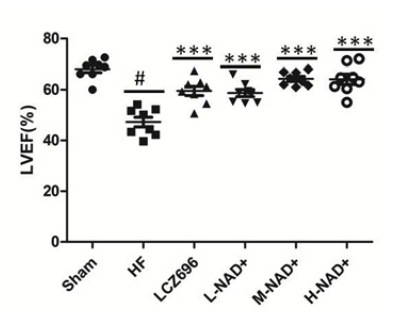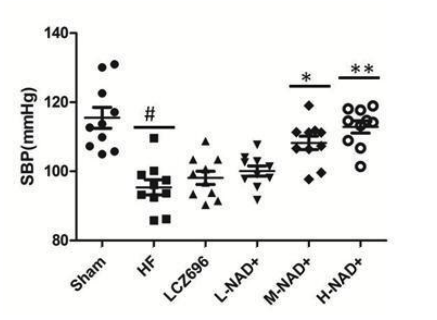This study evaluated the effect of subcutaneous NAD+ injections in Sprague-Dawley (SD) rats and beagles with heart failure.
Key Points
Subcutaneous injections of NAD+ offered several benefits for animals with heart failure:
- Heart damage was reduced
- Functionality of the heart was maintained
- Blood pressure was improved
- Scarring of the heart was minimized
Notably, a recent human trial also found that NAD+ injections improved heart function markers following heart failure.
Unlike oral administration, injecting NAD+ bypasses breakdown in the digestive system, potentially yielding different outcomes.
Study Evaluates Effect of NAD+ Injections in Rats and Beagles with Heart Failure
Animals in the heart failure groups underwent surgery to tie off a specific artery, a procedure commonly used to mimic a heart attack.
Sprague-Dawley rats (n=10 per group) and Beagles (n=8 per group) were used in the experiment.
Animals were treated for 4 weeks, starting 1 week after surgery:
- Sham group: No treatment (healthy control).
- HF group: No treatment (heart failure).
- LCZ696 group: Standard heart medication (LCZ696)
- L-NAD+ group: Low-dose NAD+ injections (rats: 15 mg/kg; beagles: 6 mg/kg)
- M-NAD+ group: Medium-dose NAD+ injections (rats: 45 mg/kg; beagles:18 mg/kg)
- H-NAD+ group: High-dose NAD+ injections (rats: 135 mg/kg; beagles: 54 mg/kg)
“The vehicle (Medical grade sterile saline) and NAD+ were administered subcutaneously, while LCZ696 was administered via oral gavage.”
Reduced Heart Damage
NAD+ lowered levels of enzymes that indicate heart damage in rats and beagles.
Heart weight was also reduced in rats.
The figure below shows the serum levels of lactic dehydrogenase (LDH), a marker of heart damage, were reduced in beagles.

Beagles receiving medium-dose NAD+ injections (M-NAD+) had significantly reduced levels of LDH compared to the other groups.
Enhanced Heart Function
In rats, all groups receiving NAD+ injection improved measures of heart function, including ejection fraction, stroke volume, and cardiac output.
Beagles also showed improvements in heart function with NAD+ injections:
- Pumping strength was improved in medium and high dose NAD+ groups
- Amount of blood pumped per beat was improved in the high dose NAD+ group
- High dose of NAD+ showed greater improvement in pumping strength than heart medication
The graph below illustrates the percentage of left ventricular ejection fraction (%LVEF) measured in the beagles, which reflects how effectively the heart pumps blood out of the left ventricle.

In beagles with heart failure (HF), the % LVEF was notably lower compared to healthy beagles (Sham). However, in the groups receiving heart medicine (LCZ696) and each dose of NAD+ (L-NAD+, M-NAD+, and H-NAD+), improvements in %LVEF were observed.
Improved Blood Pressure in Rats
Blood pressure and heart pumping pressure was improved in rats receiving medium and high doses of NAD+.
This figure shows systolic blood pressure (SBP) was reduced in rats with heart failure (HF) compared to healthy rats (Sham). Blood pressure was restored in rats that received medium (M-NAD+) and high (H-NAD+) doses of NAD+.

Reduced Heart Scarring
Rats treated with NAD+ injections (medium and high doses) had significantly less scar tissue in their hearts compared to those with untreated heart failure.
In beagles, all doses of NAD+ reduced the extent of damage caused by the heart attack compared to those without NAD+ and those receiving heart medication.
“The therapeutic effects of NAD+ in all NAD+ groups were better than those of LCZ696.”

This figure demonstrates that untreated heart failure in rats (HF) resulted in significant damage compared to healthy rats (Sham). Rats treated with NAD+ at each dose (L-NAD+, M-NAD+, and H-NAD+) showed significantly less damage compared to both the HF group and the group receiving the heart medication (LCZ696).
Conclusion
Treatment with NAD+ injections in rats and beagles with heart failure improved markers of heart function.
“This study, involving rat and beagle MI-induced HF models, indicated that NAD+ significantly improves myocardial hypertrophy and cardiac function, inhibits myocardial fibrosis, and reduces the myocardial infarction rate.”
These findings align with a recent trial indicating that NAD+ injections improved heart function in patients with heart failure.
When taken orally, most of the NAD+ is broken down into nicotinamide (NAM) in the gastrointestinal (GI) tract. However, by administering NAD+ through injections, this breakdown in the gut is bypassed, which may result in different outcomes compared to oral administration.
